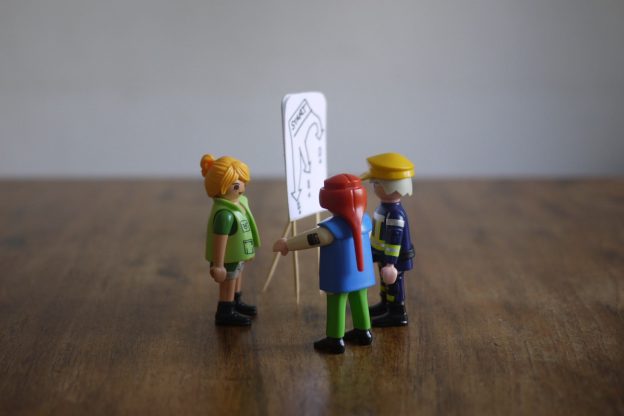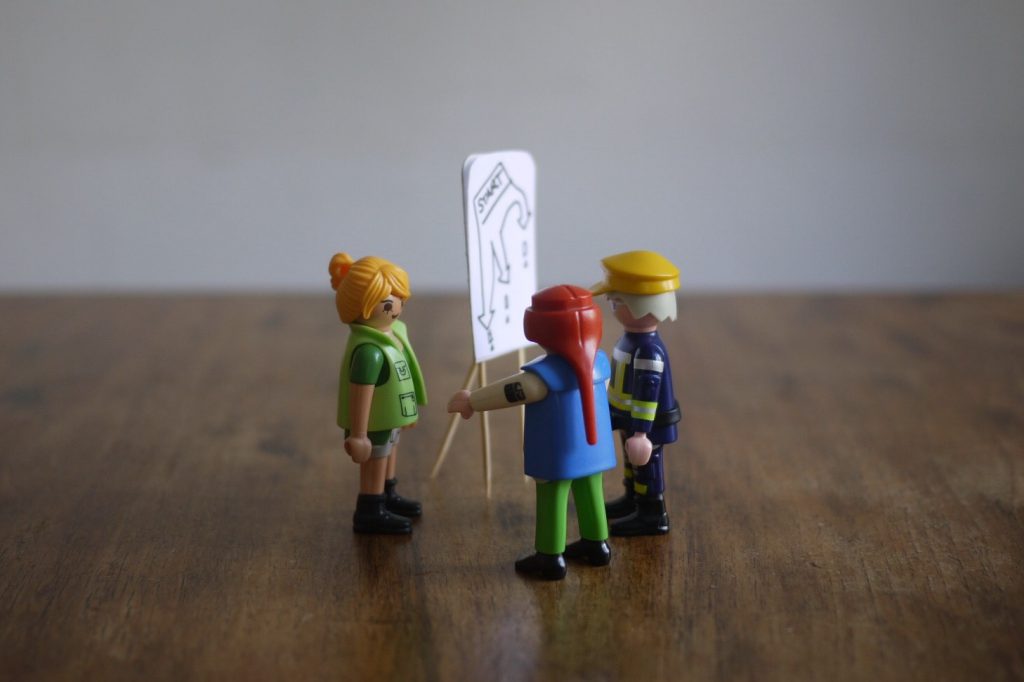
What challenges await us when we work with groups or teams that bring together participants from different hierarchical levels? This is exactly the question our five experts on working with groups are addressing in today’s meeting.
The leader’s role
„Do you know when, at a preliminary meeting for a training, the team leader or the client asks how he or she should behave at the workshop or training? For example, whether he or she should participate or be given their own tasks?“ asks Yasemine to the group. After a few nods, but also surprised faces, she continues: „The first time I was in such a situation, I was completely caught off guard. I didn’t know what to say at first. Until then, it had always been clear to me that the same applies to everyone and that everyone is somehow the same.“ Yasemine doesn’t remember exactly what she said back then. What she does remember is that she discussed the situation with her colleagues and had a few „aha“-experiences.
Formal and informal hierarchies
„What were the conclusions you drew from this?“ Beate wants to know. „First of all,“ Yasemine answers, „I realised that until then I had mainly been active in groups where – at least formally – everyone had the same creative leeway and decision-making powers. These were more or less grassroots-democratically organised groups. The organisations in which I was active as a employee also worked in this way. There were formal hierarchies, because there was an association, with the corresponding functions. But the actual practice was a grassroots democracy, with joint decision-making and consensus.“ Yasemine goes on to say that she was therefore not sensitised to teamwork, where there are formal hierarchies that also come into play accordingly in joint practice. With this realisation, she could also better understand why a leader would ask such a question at the preliminary meeting. „This is an unusual situation for such a team or department. They don’t go about their daily work where it is clear who has to do what and how the responsibilities are distributed.“
„At the workshop, everyone is a learner, but somehow they are all the same.“ Maria would now like to know how Yasemine deals with this in practice. „For me it is important to actively deal with diversity and not to hide it. Even if it’s a workshop or a seminar where the differences in hierarchy are not relevant because of the subject matter, I still pay attention to it. The team works together and certain dynamics exist, no matter what they are engaged in.“ Maria frowns, „Does that mean you give different work assignments depending on the hierarchy level?“ Yasemine answers that she only does that sometimes, when it seems to serve the goals of the workshop. Most of the time, however, everyone gets the same task, but she is concerned not to make it taboo that there are differences in the group, but to work with them. Rudi, who has also listened with great interest and nodded his head frequently so far, contributes with a literature tip, which he promises to send to everyone via email.
Hierarchy-free spaces?
Paul is interested in a completely different aspect: „Yasemine, when you used to work at the association – there really were no hierarchies? That’s hard for me to imagine, I must admit…“ Yasemine smiles and says that she has also experienced that informal hierarchies – based on age, experience or knowledge advantage, technical expertise or similar – lead to a different distribution of power. However, she has experienced the tabooing of this as really counterproductive.
„I know that well too!“ interjects Rudi. „Before my supervisor training, and also before I started working as a psychotherapist, I was active in, let’s say, alternative circles, and in the 1980s I joined an association that dealt a lot with social issues, including redistribution and so on. That was really great and exciting and I also enjoyed the hour-long discussions and opinion-forming processes, even if it was sometimes tough.“
Beate believes she sees a fire in Rudi’s eyes when he tells her about it and asks, „But what did you mean earlier that you also know this well when Yasemine talked about informal hierarchies?“ Rudi talks about how, over time, he came to realise that different rules applied to different people. On the one hand, there were very clear rules about how they came to decisions, but on the other hand, the founders of the group didn’t seem to have to abide by them as much. It was taboo to question any of their ideas or to demand a procedure that conformed to the rules. It simply gave them more power and creative freedom and no one dared to really rebel against it.
Embracing differences instead of disguising them
Yasemine sighs loudly, „Yes, I can imagine that. I’ve experienced something similar too, albeit twenty years later.“ „But how did you deal with it? I imagine that would be very difficult,“ Beate says and looks curiously at Rudi and Yasemine. Yasemine is the first to answer and says that she tried again and again to address the informal power imbalance and also called for external support. But at some point there was no more air, nothing seemed to change. The situation put more and more strain on her, and also on the team, and so she left the organisation. „But to come back to the topic – what I have taken away from this experience in any case is a guiding principle that I always remind myself of when I work with teams in which there are different hierarchies: Never negate hierarchies and pretend that everyone is equal or has the same opportunities when this is not the case!“
Next time the group will look at methods to activate participants and groups that are already a bit tired.
Authors: Gerda Kolb and Irene Zavarsky
Lust auf mehr? Zu allen Beiträgen der Serie kommst du HIER!

Dieses Werk ist lizenziert unter einer Creative Commons Namensnennung-NichtKommerziell-Weitergabe unter gleichen Bedingungen unter gleichen Bedingungen 3.0 Österreich Lizenz.
Volltext der Lizenz


